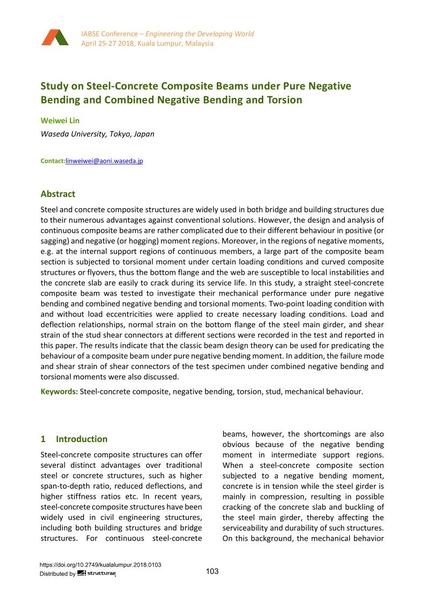Study on Steel-Concrete Composite Beams under Pure Negative Bending and Combined Negative Bending and Torsion

|
|
|||||||||||
Détails bibliographiques
| Auteur(s): |
Weiwei Lin
(Waseda University, Tokyo, Japan)
|
||||
|---|---|---|---|---|---|
| Médium: | papier de conférence | ||||
| Langue(s): | anglais | ||||
| Conférence: | IABSE Conference: Engineering the Developing World, Kuala Lumpur, Malaysia, 25-27 April 2018 | ||||
| Publié dans: | IABSE Conference Kuala Lumpur 2018 | ||||
|
|||||
| Page(s): | 103-110 | ||||
| Nombre total de pages (du PDF): | 8 | ||||
| DOI: | 10.2749/kualalumpur.2018.0103 | ||||
| Abstrait: |
Steel and concrete composite structures are widely used in both bridge and building structures due to their numerous advantages against conventional solutions. However, the design and analysis of continuous composite beams are rather complicated due to their different behaviour in positive (or sagging) and negative (or hogging) moment regions. Moreover, in the regions of negative moments, e.g. at the internal support regions of continuous members, a large part of the composite beam section is subjected to torsional moment under certain loading conditions and curved composite structures or flyovers, thus the bottom flange and the web are susceptible to local instabilities and the concrete slab are easily to crack during its service life. In this study, a straight steel-concrete composite beam was tested to investigate their mechanical performance under pure negative bending and combined negative bending and torsional moments. Two-point loading condition with and without load eccentricities were applied to create necessary loading conditions. Load and deflection relationships, normal strain on the bottom flange of the steel main girder, and shear strain of the stud shear connectors at different sections were recorded in the test and reported in this paper. The results indicate that the classic beam design theory can be used for predicating the behaviour of a composite beam under pure negative bending moment. In addition, the failure mode and shear strain of shear connectors of the test specimen under combined negative bending and torsional moments were also discussed. |
||||
